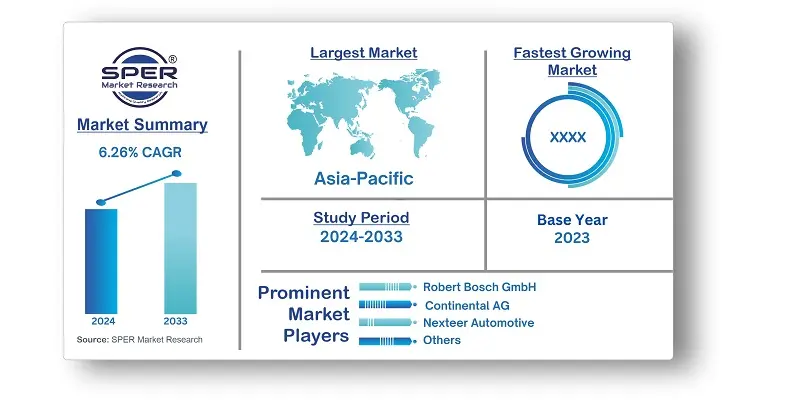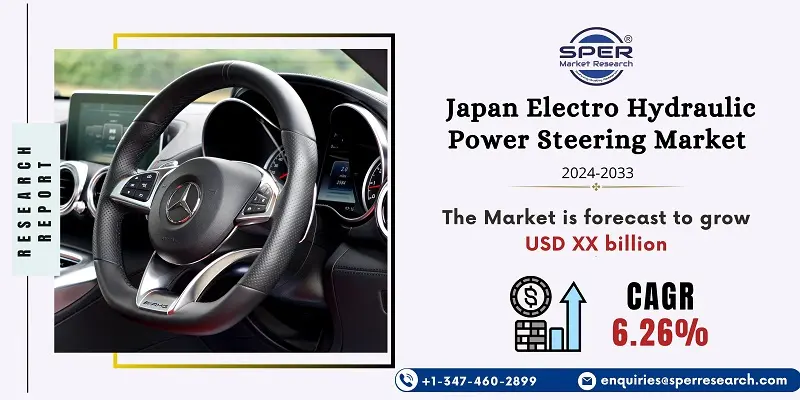
Japan Electro Hydraulic Power Steering Market Trends, Share, Size, Demand and Future Outlook
Japan Electro Hydraulic Power Steering Market Growth, Size, Trends Analysis- By Vehicle Type, By Component Type- Regional Outlook, Competitive Strategies and Segment Forecast to 2033
| Published: Nov-2024 | Report ID: AMIN24234 | Pages: 1 - 106 | Formats*: |
| Category : Automotive & Transportation | |||
- Nidec Corporation (Japan) introduced an electric power steering motor power pack (EPS-PP) in June of 2023. Nidec's newly designed EPS-PP identifies and corrects motor and EPS unit friction and torque ripple as they occur, thereby resolving the long-standing issue of artificial steering sensation.


| Report Metric | Details |
| Market size available for years | 2020-2033 |
| Base year considered | 2023 |
| Forecast period | 2024-2033 |
| Segments covered | By Vehicle Type, By Component Type |
| Regions covered | Kanto Region, Kniki Region, Central/Chubu Region, Kyushu-Okinawa Region, Chugoku Region Shikoku Region |
| Companies Covered | JTEKT Corporation, Nexteer Automotive, NSK Ltd, Robert Bosch GmbH, ZF Friedrichshafen AG, Showa Group, Danfoss, Continental AG, Thyssenkrupp Presta AG, Mando Corporation. |
- Automobile Manufacturers and OEMs
- Commercial Vehicle Manufacturers
- Passenger Vehicle Manufacturers
- Electric and Hybrid Vehicle Manufacturers
- Automotive Component Suppliers
- Aftermarket Service Providers
- Automotive Repair and Maintenance Centers
- Fleet Management and Logistics Companies
- R&D and Engineering Firms in Automotive Technology
| By Vehicle Type: | |
| By Component Type: |
- Japan Electro Hydraulic Power Steering Market Size (FY’2024-FY’2033)
- Overview of Japan Electro Hydraulic Power Steering Market
- Segmentation of Japan Electro Hydraulic Power Steering Market By Vehicle Type (Passenger Vehicles and Commercial Vehicles)
- Segmentation of Japan Electro Hydraulic Power Steering Market By Component Type (Steering Motor, Sensors, and Others)
- Statistical Snap of Japan Electro Hydraulic Power Steering Market
- Expansion Analysis of Japan Electro Hydraulic Power Steering Market
- Problems and Obstacles in Japan Electro Hydraulic Power Steering Market
- Competitive Landscape in the Japan Electro Hydraulic Power Steering Market
- Impact of COVID-19 and Demonetization on Japan Electro Hydraulic Power Steering Market
- Details on Current Investment in Japan Electro Hydraulic Power Steering Market
- Competitive Analysis of Japan Electro Hydraulic Power Steering Market
- Prominent Players in the Japan Electro Hydraulic Power Steering Market
- SWOT Analysis of Japan Electro Hydraulic Power Steering Market
- Japan Electro Hydraulic Power Steering Market Future Outlook and Projections (FY’2024-FY’2033)
- Recommendations from Analyst
1.1. Scope of the report1.2. Market segment analysis
2.1. Research data source2.1.1. Secondary Data2.1.2. Primary Data2.1.3. SPER’s internal database2.1.4. Premium insight from KOL’s2.2. Market size estimation2.2.1. Top-down and Bottom-up approach2.3. Data triangulation
4.1. Driver, Restraint, Opportunity and Challenges analysis4.1.1. Drivers4.1.2. Restraints4.1.3. Opportunities4.1.4. Challenges4.2. COVID-19 Impacts of the Japan Electro Hydraulic Power Steering Market
5.1. SWOT Analysis5.1.1. Strengths5.1.2. Weaknesses5.1.3. Opportunities5.1.4. Threats5.2. PESTEL Analysis5.2.1. Political Landscape5.2.2. Economic Landscape5.2.3. Social Landscape5.2.4. Technological Landscape5.2.5. Environmental Landscape5.2.6. Legal Landscape5.3. PORTER’s Five Forces5.3.1. Bargaining power of suppliers5.3.2. Bargaining power of buyers5.3.3. Threat of Substitute5.3.4. Threat of new entrant5.3.5. Competitive rivalry5.4. Heat Map Analysis
6.1. Japan Electro Hydraulic Power Steering Market Manufacturing Base Distribution, Sales Area, Product Type6.2. Mergers & Acquisitions, Partnerships, Product Launch, and Collaboration in Japan Electro Hydraulic Power Steering Market
7.1. Japan Electro Hydraulic Power Steering Market Size, Share and Forecast, By Vehicle Type, 2020-20267.2. Japan Electro Hydraulic Power Steering Market Size, Share and Forecast, By Vehicle Type, 2027-20337.3. Passenger Vehicles7.4. Commercial Vehicles
8.1. Japan Electro Hydraulic Power Steering Market Size, Share and Forecast, By Component Type, 2020-20268.2. Japan Electro Hydraulic Power Steering Market Size, Share and Forecast, By Component Type, 2027-20338.3. Steering Motor8.4. Sensors8.5. Others
9.1. Japan Electro Hydraulic Power Steering Market Size and Market Share
10.1. Japan Electro Hydraulic Power Steering Market Size and Market Share By Region (2020-2026)10.2. Japan Electro Hydraulic Power Steering Market Size and Market Share By Region (2027-2033)10.3. Kanto Region10.4. Kinki Region10.5. Central/ Chubu Region10.6. Kyushu-Okinawa Region10.7. Chugoku Region10.8. Shikoku Region
11.1. JTEKT Corporation11.1.1. Company details11.1.2. Financial outlook11.1.3. Product summary11.1.4. Recent developments11.2. Nexteer Automotive11.2.1. Company details11.2.2. Financial outlook11.2.3. Product summary11.2.4. Recent developments11.3. NSK Ltd11.3.1. Company details11.3.2. Financial outlook11.3.3. Product summary11.3.4. Recent developments11.4. Robert Bosch GmbH11.4.1. Company details11.4.2. Financial outlook11.4.3. Product summary11.4.4. Recent developments11.5. ZF Friedrichshafen AG11.5.1. Company details11.5.2. Financial outlook11.5.3. Product summary11.5.4. Recent developments11.6. Showa Group11.6.1. Company details11.6.2. Financial outlook11.6.3. Product summary11.6.4. Recent developments11.7. Danfoss11.7.1. Company details11.7.2. Financial outlook11.7.3. Product summary11.7.4. Recent developments11.8. Continental AG11.8.1. Company details11.8.2. Financial outlook11.8.3. Product summary11.8.4. Recent developments11.9. Thyssenkrupp Presta AG11.9.1. Company details11.9.2. Financial outlook11.9.3. Product summary11.9.4. Recent developments11.10. Mando Corporation11.10.1. Company details11.10.2. Financial outlook11.10.3. Product summary11.10.4. Recent developments11.11. Others
SPER Market Research’s methodology uses great emphasis on primary research to ensure that the market intelligence insights are up to date, reliable and accurate. Primary interviews are done with players involved in each phase of a supply chain to analyze the market forecasting. The secondary research method is used to help you fully understand how the future markets and the spending patterns look likes.
The report is based on in-depth qualitative and quantitative analysis of the Product Market. The quantitative analysis involves the application of various projection and sampling techniques. The qualitative analysis involves primary interviews, surveys, and vendor briefings. The data gathered as a result of these processes are validated through experts opinion. Our research methodology entails an ideal mixture of primary and secondary initiatives.



Frequently Asked Questions About This Report
PLACE AN ORDER
Year End Discount
Sample Report
Pre-Purchase Inquiry
NEED CUSTOMIZATION?
Request CustomizationCALL OR EMAIL US
100% Secure Payment






Related Reports
Our Global Clients
Our data-driven insights have influenced the strategy of 200+ reputed companies across the globe.




















